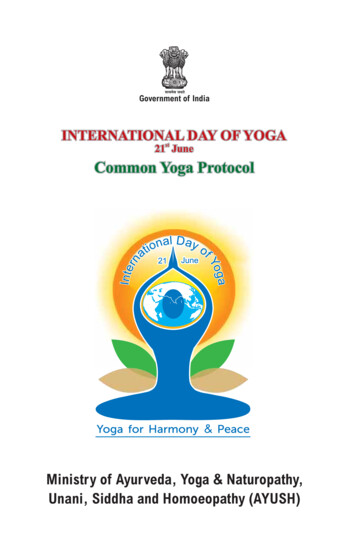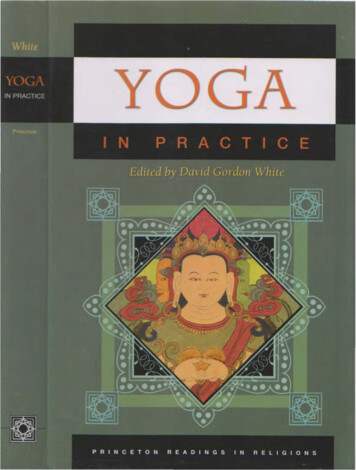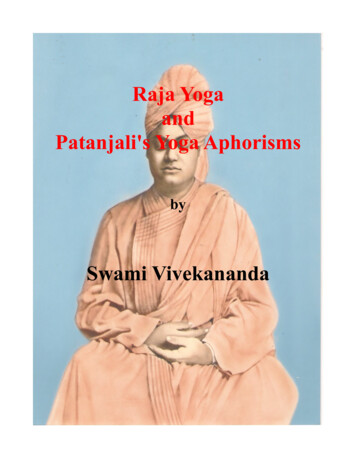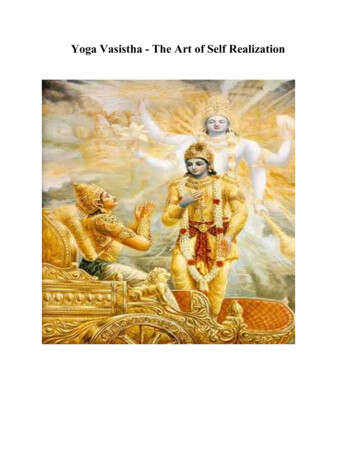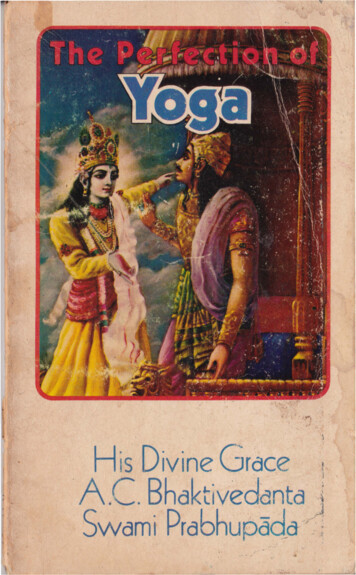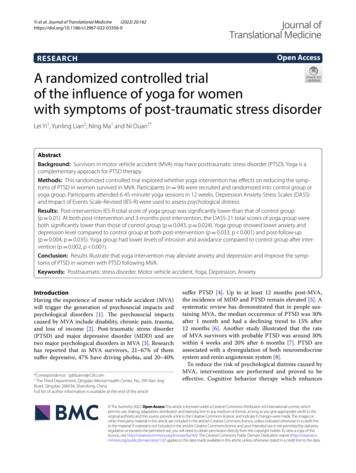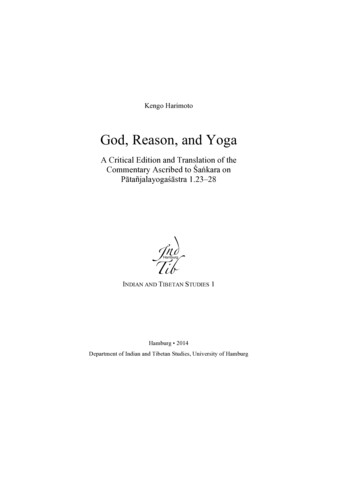
Transcription
Kengo HarimotoGod, Reason, and YogaA Critical Edition and Translation of theCommentary Ascribed to Śaṅkara onPātañjalayogaśāstra 1.23–28ndITibHamburgINDIAN AND TIBETAN STUDIES 1Hamburg 2014Department of Indian and Tibetan Studies, University of Hamburg
God, Reason, and Yoga
ndITibHamburgINDIAN AND TIBETAN STUDIESEdited by Harunaga Isaacson and Dorji WangchukVolume 1Hamburg 2014Department of Indian and Tibetan Studies, University of Hamburg
God, Reason, and YogaA Critical Edition and Translation of theCommentary Ascribed to Śaṅkara onPātañjalayogaśāstra 1.23–28Kengo HarimotondITibHamburgINDIAN AND TIBETAN STUDIES 1Hamburg 2014Department of Indian and Tibetan Studies, University of Hamburg
Published by the Department of Indian and Tibetan Studies, Asia-AfricaInstitute, University of Hamburg, Alsterterrasse 1, D-20354 Hamburg,Germany Department of Indian and Tibetan Studies, University of Hamburg, 2014ISBN: 978-3-945151-00-6First published 2014All rights reserved.Apart from any fair dealing for the purpose of private study, research, criticismor review, no part of the book may be reproduced or translated in any form, byprint, photoprint, microform or any other means without written permission.Enquiry should be made to the publishers.Printing and distribution:Aditya Prakashan, 2/18 Ansari Road, New Delhi, 110 002, India.Email: contact@adityaprakashan.comWebsite: www.adityaprakashan.com
iationsTexts and editions . . . . . . . . . . . . . . . . . . . . . . . . . .Sigla and Others . . . . . . . . . . . . . . . . . . . . . . . . . . .113Introduction5General IntroductionScope of this volume . . .Title of the work . . . . .Īśvara section of the YVi .The author . . . . . . . .Introduction to the Edition in ThisCall for a new edition . . . . . . . .Manuscripts . . . . . . . . . . . . . .Relationship among manuscripts . .Editorial principles . . . . . . . . . .7. 7. 9. 9. 11Volume. . . . . . . . . . . . . . . . . . . . .1515162533Critical Text45Critical Text 1.2347Critical Text 1.2447Critical Text 1.2553Critical Text 1.2677Critical Text 1.2780i
iiCONTENTSCritical Text 1.2883Translation85Commentary on Pātañjalayogaśāstra 1.2387Commentary on Pātañjalayogaśāstra 1.2489Commentary on Pātañjalayogaśāstra 1.2599Commentary on Pātañjalayogaśāstra 1.26141Commentary on Pātañjalayogaśāstra 1.27151Commentary on Pātañjalayogaśāstra 1.28165Appendices169Critical Text 1.1171Translation of the Commentary on Pātañjalayogaśāstra 1.1 185Opening stanzas . . . . . . . . . . . . . . . . . . . . . . . . . . . 185Commentary on Pātañjalayogaśāstra 1.1 . . . . . . . . . . . . . . 186The ending of the YViTranscripts . . . . . . . . . . . . . . . . . . .An edition of the common part . . . . . . . .An edition of the colophon stanza of Tm . . .An edition of colophon stanzas of L . . . . . .Notes on the 1952 edition . . . . . . . . . . .Layers in the ending of the YVi manuscripts.207207209215219221222Materials for the Authorship Problem225Chronology of controversy . . . . . . . . . . . . . . . . . . . . . . 225Criteria of Hacker and Mayeda . . . . . . . . . . . . . . . . . . . 242The Payyur Family . . . . . . . . . . . . . . . . . . . . . . . . . . 247Bibliography253Index267
PrefaceThis book has been in the making for too long. The initial idea wasto publish an improved version of my doctoral thesis submitted to theUniversity of Pennsylvania in 1999. It was a critical edition of the firstchapter (pāda) of the Pātañjalayogaśāstravivaraṇa (i.e., the Yogasūtra its commentary, the Yogabhāṣya). When I was preparing the book inHamburg in 2001, the hard drive of my computer crashed and took allthe contents with it, including the source for the whole book. At thattime, I had not been able to afford another hard drive for backup and Ihad trusted the mechanical device too much. What little backup I hadwas extremely old. In order to make a better use of the opportunity, Idecided to re-do the whole thing. In the meantime, the software had beenevolving and I decided to adopt to the new software situation. In 2005,while I was in Leiden as a Gonda Fellow, I was persuaded by Arlo Griffithsand the late Professor Tilmann Vetter to provide a translation. It was asensible thing to do. I am thankful to both of them. By looking at thetext again thoroughly, producing a translation, I believe the critical texthas improved much. Also, we decided to read the part on Īśvara in thetext since I thought that part might be interesting for Professor Vetter.By the end of the period as a Gonda Fellow, I made a decision to haveonly the part we read in Leiden as a book to accelerate the process. By2006, the book was 90% ready, I thought. I cannot quite explain why ittook so long till this book is finally out. I am the only person to be blamedfor the delay.I find it ironical that in the end, this books deals with in principle thesame part of the Vivaraṇa as my master’s thesis did. It feels as if I amgoing back to my roots. I hope my scholarly experiences in the meantimegave me better understanding of that part.There have already been two complete translations of the whole ofthe Vivaraṇa, based on the Madras edition published in 1952. I trust,however, that there still is room for this book with an improved editionof the text itself and many notes accompanying the translation.I do intend to publish an edition and translation of the rest of thefirst chapter of the Vivaraṇa. The other parts also contain importantdiscussions in terms of the history of Indian philosophy. This first installment took too long. I hope the next one will not take that long. Also,I am considering to present my thoughts on the authorship problem ofiii
ivPREFACEthe Vivaraṇa—whether it was written by the famous commentator on theBrahmasūtra, Śaṅkara—in the form of a separate volume. In this book,readers will find my observations on the issue in the form of footnotes or inthe appendix. They probably will get an impression where I might stand.However, I have not formed a final opinion even after all these years. Theissue needs a systematic treatment and I should make a clear statementregarding the issue. I would like to ask the readers to pray for an earlycompletion of the book.This book is typeset using the XƎLATEX typesetting system. The document class is memoir and for the critical text, the ednotes suite is used. Thebook is typeset in Latin Modern family of fonts alongside the DevanagariMT font for the Devanagari text.Hamburg, May 2014Kengo Harimoto
AcknowledgementsThis book owes much to two German scholars who are sadly not with usany more. I am sorry for not being able to present this book in front ofthem. They are the late Professor Dr. Wilhelm Halbfass, and the lateProfessor Dr. Tillman Vetter.Professor Halbfass was the patient supervisor of my doctoral thesis inmy five and a half years at Penn in Philadelphia. Knowing my interestin the Pātañjalayogaśāstravivaraṇa, he almost matter-of-factly suggestedthat I prepare a critical edition of the text as the topic for my doctoraldissertation. I did not have to think much before saying yes. He also madeit possible that I had access to manuscripts. The thesis became the basisof this book. I am not happy that I became one of his very last students.Professor Vetter practically determined the content of this book. Evenbefore I met him, a brief remark in one of his writings directed me to lookat the Īśvara section of the Vivaraṇa. I was fortunate to meet him yearslater, as a Gonda Fellow in Leiden in 2005 to 2006. He agreed to read myedition with me. In view of the limited time period, I asked him to readthe Īśvara section in which I thought he might be interested. In the end,it is not a coincidence that the content of this book corresponds to thepart we read together, including the commentary on sūtra 1.1. It was alsohe who insisted that I have a translation to read the edition with him.I also owe much to Professor Albrecht Wezler. He agreed that I workon a critical edition of the Pātañjalayogaśāstravivaraṇa and let me usehis copies of the Lahore manuscript which has always been difficult togain access to. After I came to Hamburg in 2000, he arranged weeklyreading sessions for the edition I prepared for my thesis. Much of theimprovements in the text come from those reading sessions between 2000and 2002.I am thankful to all my teachers. Professor Osamu Hayashima firsttaught me Sanskrit. It might be that I am the only person who still readsSanskrit among his students. The way he taught me Sanskrit was veryefficient; he told me to learn it by myself. Professor Hiromasa Tosakiimparted to us what it is to be a scholar. Professor Akihiko Akamatsuintroduced me to the concept of philology. It took some time for me todigest the concept but I hope now I get it. I have learned many manythings from Dr. Futoshi Omae when he was an assistant at the KyushuUniversity. It might have been during the daily chatting over many thingsv
viACKNOWLEDGEMENTSwith him that I learned most about our field of studies.When I was at Penn, it was a golden age for classical indological studiesthere. We had Professors Halbfass, George Cardona, Ludo and RosaneRocher and many inspiring fellow students. I learned various things fromall of them. I have so many fond memories of my time in Philadelphia. Oneof them is the memory of reading the Vākyapadīya with Prof. Cardonafor five years.Working for the Skandapurāṇa project, led by Professor Hans Bakker,in Groningen, the Netherlands, was a new experience for me. Exposureto the Dutch Indology had an effect on me. I had to reshape my selfperception as an indologist. I also thank Prof. Bakker’s support/insistenceto finish this book as soon as possible.The same thanks go to Arlo Griffiths whom I first met in 1997 or so atan AOS meeting before seeing each other again in Groningen in 2004. He,too, has been supportive and persuasive. He arranged that I could readmy text with Professor Vetter. He also looked at my English many times.I was also fortunate to have had an opportunity to work with ProfessorYuko Yokochi in Groningen. In 2012, she arranged an intensive courseto read the Vivaraṇa at the Kyoto University. Inputs from scholars andstudents there were very valuable. The people who were present thereinclude Diwakar Acharya, Somdev Vasudeva, Akihiro Kanabishi, KoretoIkehata.Special mention has to be made to Harunaga Isaacson with whomI seem to share some fate in that we have been moving symmetricallyaround Hamburg in the past 14 years. Not only has he been a tremendousinspiration, without him, this book would have been impossible. If thereis any quality in it, it is largely because of him. I sincerely thank him forhis support, not only for this book but also for everything.There are many other people to whom thanks are due. Here are someof the names: Ashok Aklujkar, Orna Almogi, Loriliai Biernacki, Piotr Balcerowicz, Benita von Behr, Bidur Bhattarai, Peter Bisschop, Tim Cahill,Britton Chance†, Danielle Cuneo, Jonathan Duquette, Christina Edingloh, John Freeman, Camillo A. Formigatti, Angelika Frankowski, ElisaFreschi, Takamichi Fujii, Dominic Goodall, Kunihiro Harikai, Tomoko Himeno, Kazuo Kano, Kei Kataoka, Kenichi Kuranishi, Andrey Klebanov,Masato Kobayashi, Stasinos Konstantopoulos, Sonja Lakner, Philipp Maas,Kristin McGee, David Mellins, Mai Moriguchi, Shin’ya Moriyama, Yasutaka Muroya, Hodo Nakamura, Masanori Nakagawa, David Nelson, HeidiNeubert, Sachio Nioka, Shoko Nioka, Luther Obrock, Kiyokazu Okita,Dimitri Pauls, Kim Plofker, Akane Saito, Florinda de Simini, BarbaraSchuler, Greg Seton, Francesco Sferra, Taisei Shida, Kiyokuni Shiga, Jaekwan Shim, Iain Sinclair, Michael Slouber, Hans-Jörg Stein, VidyasankarSundaresan, Peter Szanto, Masaya Takahashi, Ryugen Tanemura, SomdevVasudev, Dorji Wangchuk, Eiichi Yamaguchi.Since it took so long to complete this book, practically anyone I knewhas been in one way or another influential. I would like to thank all the
ACKNOWLEDGEMENTSviifriends I have ever had. And at last but not least, the biggest thanks aredue to my parents for their unwavering support.
AbbreviationsTexts and hūAṣṭādhyāyī of Pāṇini (Vasu 1962)Bṛhadāraṇyakopaniṣad (Shastri 1986)Bṛhadāraṇyakopaniṣadbhāṣya ascribed to Śaṅkara (Shastri1986)Bhagavadgītā (Paṇśīkar 1978)Bhagavadgītābhāṣya ascribed to Śaṅkara (Paṇśīkar 1978)Brahmasūtra (Śāstri and Paṇśīkar 1917)Brahmasūtraśāṅkarabhāṣya of Śaṅkara (Śāstri and Paṇśīkar1917)Brahmasiddhi of Maṇḍana Miśra (Sastri 1984)Chāndogyopaniṣad (Shastri 1982)Chāndogyopaniṣadbhāṣya ascribed to Śaṅkara (Shastri 1982)Jaiminisūtra a.k.a. Mīmāṃsāsūtra (Frauwallner 1968, Śāstriet al. 1976, 1929, Āpaṭe et al. 1930, 1931, 1932, 1933, 1934a,b)Kauṭilyārthaśāstra (Kangle 1960)Kaṭhopaniṣad (Shastri 1979)Kaṭhopaniṣadbhāṣya ascribed to Śaṅkara (Shastri 1979)Kenopaniṣad (Shastri 1979)Kenopaniṣadbhāṣya ascribed to Śaṅkara (Shastri 1979)Manusmṛti (Olivelle 2006)Māṇḍūkyopaniṣad (Shastri 1979)Māṇḍūkyopaniṣadbhāṣya ascribed to Śaṅkara (Shastri 1979)Mahābhārata (Sukthankar et al. 1927)Mūlamadhyamikakārikās of Nāgārjuna (de la Vallée Poussin1913)Muṇḍakopaniṣad (Shastri 1979)Muṇḍakopaniṣadbhāṣya ascribed to Śaṅkara (Shastri 1979)Nyāyabhāṣya (Tarkatirtha and Tarkatirtha 1985)Nyāyabhūṣaṇa of Bhāsarvajña (Yogīndrānanda 1967)1
YVYViABBREVIATIONSNyāyakandalī (Dvivedin 1984)Nyāyakaṇikā of Vācaspati Miśra (Tailanga 1907, Goswami1978, Stern 1988)Nyāyamañjarī of Bhaṭṭa Jayanta (Śukla 1936)Nyāyasūtra (Tarkatirtha and Tarkatirtha 1985)Nyāyavārttika (Tarkatirtha and Tarkatirtha 1985)Nyāyavārttikatātparyaṭīkā of Vācaspati Miśra (Tarkatirtha andTarkatirtha 1985)Padārthadharmasaṅgraha (Dvivedin 1984)Pāśupatasūtra (Ananthakrishna Sastri 1940)Prakaraṇapañcikā (Sastri 1964)Pātañjalayogaśāstra (Āgāśe et al. 1919, Śāstrī and Śāstrī 1952)Pramāṇavārttika of Dharmakīrti (Shastri 1968b, Pandeya 1989)Śābarabhāṣya (Frauwallner 1968, Śāstri et al. 1976, 1929, Āpaṭeet al. 1930, 1931, 1932, 1933, 1934a,b)Sāṃkhyakārikās (Pandeya 1967)Tattvasaṃgraha of Śāntarakṣita (Shastri 1968a)Sphoṭasiddhi of Maṇḍana Miśra (Śāstri 1931)Ślokavārttika of Kumārila (Sastri 1971, Śāstrī 1978, Sastri 1943)Taittirīyopaniṣad (Shastri 1979)Taittirīyopaniṣadbhāṣya ascribed to Śaṅkara (Shastri 1979)Taittirīyasaṃhitā (Weber 1871)Tattvasaṃgrahapañjikā of Kamalaśīla (Shastri 1968a)Tattvavaiśāradī (a commentary on the Yogabhāṣya) of Vācaspati Miśra (Āgāśe et al. 1919, Śāstrī and Śāstrī 1952)Upadeśasāhasrī (Mayeda 1973)Vidhiviveka of Maṇḍana Miśra (Tailanga 1907, Goswami 1978,Stern 1988)Mahābhāṣya of Patañjali (Kielhorn and Abhyankar 1985, 1972)Vākyapadīya of Bhartṛhari (Rau 1977, 1988, Iyer 1983)Vaiśeṣikasūtra (Jambūvijayajī 1961)Yogabhāṣya (Āgāśe et al. 1919, Śāstrī and Śāstrī 1952, Maas2006)Yuktidīpikā (Wezler and Motegi 1998)Yogasūtra (Āgāśe et al. 1919, Śāstrī and Śāstrī 1952, Maas2006)Yogavārttika of Vijñānabhikṣu (Rukmani 1981–89)Pātañjalayogaśāstravivaraṇa (Śāstrī and Śāstrī 1952)
SIGLA AND OTHERSSigla and OthersSee pp. 41 for MpcAAacApcℰΣ†क.[ · ]·क ⟨क⟩»क « manuscriptemendationconjectureTrivandrum manuscriptditto before correctionditto after correctionA transcript of the Trivandrum manuscriptditto before correctionditto after correctionA reading common in Tm and TdLahore manuscriptditto before correctionditto after correctionMadras Government Oriental Manuscript Library manuscriptditto before correctionditto after correctionAdyar Library manuscriptditto before correctionditto after correction1952 edition of the YViall the witnesses, including the 1952 editionthe following text is lost in Tmthe preceding text is lost in Tmthe following text is reported missing in Tdthe preceding text is reported missing in Tdthe enclosed text is suspected to be corrupt(text in a lighter shade) uncertain textin critical text, suspected loss of textphysically lost sign in a manuscripta sign indicated as lost in the exemplarhighly illegible but ascertainable as कan illegible (but not lost) signcancelled कinserted कspace left by scribe3
Introduction5
General IntroductionScope of this volumeThe subject matter of this volume is the Pātañjalayogaśāstravivaraṇa(YVi): a commentary on the Pātañjalayogaśāstra, the combined Yogasūtra (YS) and its commentary, the Yogabhāṣya (YBh).1 The whole ofthe YVi was first published as the Pātañjala-yogasūtra-bhāṣya-vivaraṇamof Śaṅkara-bhagavatpāda by P. S. Rama Sastri and S. R. KrishnamurthiSastri in Madras in 1952. This volume presents a new edition of the sectionwhere Īśvara (God) is generally the main subject, i.e., the commentary onYS 1.23–28.1 See Maas (2006: xii–xix), Wezler (1983: 17–8), and Bronkhorst (1985: 203) for theuse of the term Pātañjalayogaśāstra. It is beyond the scope of this volume to discussthe original composition of the Pātañjalayogaśāstra—whether the sūtras were compiledby the author of the Bhāṣya or the sūtras existed already when the Bhāṣya was written,who the author was or authors were, etc. As far as the YVi is concerned, its authorstates that it is an explanation (vivaraṇa) of the pātañjalayogaśāstra [see p. 187]. Giventhe prevalent indifference to using strict titles when referring to texts in the Sanskriticculture, we cannot assume the word pātañjalayogaśāstra meant the title. It can justbe a generic designation of what it is (see below). Nonetheless, the author was fullyaware that the śāstra he comments upon consists of sūtras and the Bhāṣya; wordssuch as sūtra, bhāṣya, sūtrakāra, and bhāṣyakāra occur frequently in the YVi. Asidefrom what the author of the YVi considered to be the Pātañjalayogaśāstra, there is anambiguity whether the YBh itself treats only the YS as the śāstra or it includes itselfas part of the śāstra. The word śāstra is used in the YBh itself, paraphrasing the wordyogānuśāsanam in the very first sūtra with śāstram. From this, it might seem thatthe Bhāṣya treats the teaching expounded only in the following sūtras as the śāstra.On the other hand, the combined beginning of the YS and the YBh imitates that ofthe Mahābhāṣya (VMBh). The combined beginning of YS 1.1 and its Bhāṣya is thusapparently designed to form an integral whole. In that sense, the word śāstra mightrefer to the work inclusive of the place that uses the word, viz., the Bhāṣya. At anyrate, I will use the expression “Pātañjalayogaśāstra” sometimes to refer to the combinedwhole of the YS and YBh, as it seems to be the designation the author of the YVi uses.Today, it is generally accepted that the author of the YS is Patañjali and that of theYBh Vyāsa but the author of the YVi does not appear to hold that view. Although wedo not know who he thought were (or was) the author(s) of the Pātañjalayogaśāstra,we can still be relatively certain of the following: that he did not see any link betweenPatañjali, the author of the VMBh, or Vyāsa, the author of the Mahābhārata (MBh),and the text he was commenting on, the YS and the YBh. He refers to both by namebut Patañjali as the author of the VMBh. See Śāstrī and Śāstrī (1952: 299) and relatednotes 366 on p. 194 and 368 on p. 194; for Vyāsa as the author of the MBh, see note521 on p. 246.7
8INTRODUCTIONThis book consists of four parts: an introduction, critical text of YVi1.23–28, its translation, and appendices. The introduction is divided intotwo parts: a general introduction (this part) and an introduction to thecritical text. The general introduction discusses the scope of the volume,the title of the text, the significance of the Īśvara section (1.23–28) of theYVi, and briefly touches upon the author of the YVi.The introduction to the edition discusses the need for a new editionof the YVi, manuscripts of the YVi used in the edition, the relationshipbetween the manuscripts, and editorial principles. The last includes discussions on how the text is presented and explains the relatively complexcritical apparatus.The translation is provided to demonstrate how I understand the text.How the editor understands a text is probably the most crucial part ofediting a text, i.e., hypothesizing a state of the text, the hypothesis beingpresented as the constituted text. A translation of a segment of the textshould clarify why the editor reached the hypothesis that is the reading ofthe corresponding part of the text. The translation augments the criticalapparatus. To achieve that goal, I heavily utilize footnotes in the translation to elaborate text critical issues in hand and the reasoning to reach theconstituted reading. Various other issues are discussed in footnotes; someprovide background information that helps understand the text; some arerelated to what root text our author was commenting on;2 and others maybe about related passages in other texts.The appendices consist of a critical text of the beginning of the YVi upto the commentary on YS (and YBh) 1.1; its translation; discussions onthe end of the YVi; and some materials related to the authorship problem.The beginning of the YVi, particularly the opening stanzas, is relevant tothe main body of this volume since they allude to points discussed in theĪśvara section. Also, the commentary on the first sūtra sets the tone of thewhole commentary by exhibiting the author’s attitude toward the root textand several philosophical systems. It also gives some hint when the textwas written. My plan is to publish a new edition of the whole of the firstpāda of the YVi. The edition and translation of YVi 1.1 included here alsoserves as part of that undertaking. Similarly, the end of the text providesvarious information about the author. Some of the stanzas recorded at theend of manuscripts most likely come from the author’s own hand. Theremaining appendices reproduce some parts of my doctoral dissertationsubmitted in 1999 in which I discussed the authorship of the YVi. Since,as in the case of many other texts, the colophons of the manuscripts of theYVi ascribes the text to a Śaṅkarabhagavatpāda, whether the author isthe same person as the famous author of the Brahmasūtraśāṅkarabhāṣya(BSBh) becomes an issue. I may be disappointing some readers for notfully exploring the authorship problem. I plan to give it a full treatmentin a separate volume. This part of the appendix prepares for the fulltreatment.2 Seenote 88 on p. 43 for the significance of the root text preserved in the YVi.
GENERAL INTRODUCTION9Title of the workWhen our text was first published, its editors called it the Pātañjalayogasūtrabhāṣyavivaraṇa, and this title has been generally followed in manysubsequent publications. Wezler (1983: 17), however, suggested that thetext should be called the Pātañjalayogaśāstravivaraṇa, following the firstprose sentence of the text m ārabhyate 3However, I consider this reading to be corrupt and propose the readingathetyādi pātañjalayogaśāstram; tasya vivaraṇam ārabhyate 4This, in effect, annuls the main argument of Wezler who thought thatthe title was explicitly mentioned in the beginning of the text. It ratherappears that the author did not conceive of any specific title for his commentary. This opening is formulaic and blandly states what the workis.Nonetheless, we have no viable alternative for the title of our text. Itis probably appropriate to call our text the Pātañjalayogaśāstravivaraṇa,following Wezler’s suggestion, as a convention. The author states that itis a commentary on the Pātañjalayogaśāstra at any rate.Īśvara section of the YViThis volume presents an edition and translation of the part of the YViwhere Īśvara is the focus, i.e., the commentary on YS 1.23–28. YS 1.23introduces Īśvara as the object of contemplation (praṇidhāna); contemplating on Īśvara is taught to bring the acquisition of samādhi extremelynear. The next sūtra (1.24) characterizes Īśvara as a special puruṣa, aSāṃkhya term for consciousness, who is not tainted by deposits (āśaya)of impurities (kleśa), deeds (karman), and ripening (vipāka). The next sūtra (1.25) is, according to the author of our commentary, an inference toprove the existence of Īśvara. YS 1.26 then teaches that Īśvara is the firstteacher of all teachers. YS 1.27 teaches that the signifier of Īśvara is thesyllable om, followed by the next sūtra (1.28) that teaches how to use it:one should mutter the syllable and visualize what it represents (Īśvara).The YVi on these sūtras is notable for several reasons.5 First of all,the YVi is outwardly unique in having a very long commentary on thesesūtras, and of course the Bhāṣya accompanying them, particularly on sūtra1.25. In length, the section on the six sūtras out of 190 sūtras of theentire YS occupies about 9% of the whole text. The commentary on sūtra3 Thisin fact is not precisely how the 1952 edition reads. It reads vivaraṇam ārabhyate (Śāstrī and Śāstrī 1952: 1,21). Accordingto the editors, this means that they prefer the reading sūtrabhāṣyavivaraṇam ratherthan śāstravivaraṇam. The reading found in all the manuscript is what they do notprefer ( śāstravivaraṇam). And this is the reading adopted by Wezler.4 See p. 172 for the text and parallel openings in the commentaries ascribed toŚaṅkara. See also note 338 on p. 187 for the discussion on adopting this reading.5 Cf. Vetter (1979: 21).
10INTRODUCTION1.25 alone occupies about 6% of the whole text. In number of syllables,the whole section is equivalent of about 500 ślokas, about the size of asmall work.The opening stanzas also indicate the importance of the part in theentire commentary. They allude to major themes discussed in it.6 Exceptfor one pāda (1d), we can point out references to the Īśvara section.7 Theopening stanzas do not simply express allegiance to God who happens tobe mentioned in the work being commented. Some points mentioned inthe second stanza are not found in the sūtras or the Bhāṣya, but only inthe YVi.8 Thus, for the author, what he introduces in the commentarywas equally important as the attributes of Īśvara mentioned in the YS. Asa śāstric work, the fact that its opening stanzas mention the contents ofa part of it is an indication that that part was central to the whole work.The content of the section is indeed unique and worth studying. Īśvara is certainly a widely discussed topic in many philosophical works. TheYVi has several peculiarities even among them.The most significant is that the author (possibly correctly) interpretsthe Bhāṣya on YS 1.25 as explaining the sūtra as an inference. The argument, recognized by Nakamura as analogous to the ontological argumentin Christian theology (Nakamura 1979–83: pt. 22, p. 37), is unique in thatmost authors who wrote on Īśvara, either for or against, do not refer to thesūtra as an argument for an omniscient being. The argument, in accordance to our author’s understanding, may be paraphrased as “Knowledgehas degrees; anything that has degrees reaches its peak somewhere; theperson in whom knowledge has reached the peak is omniscient.”9 Thereare obviously several assumptions in this and the author tries to rationalize them here and there. One assumption is that knowledge that hasreached its peak (necessarily) has “everything” as object. He even goesone step further to state that knowledge about everything has infinity asits object because there are infinite number of things to know. The au6 An edition of the opening stanzas is presented in Critical Text 1.1, pp. 171 ff. ofthis volume. Their translation is found in pp. 185–186. For specific references andallusions, see notes in the edition and the translation.7 The fourth pāda of the first stanza identifies Īśvara as Viṣṇu. This identification,or more precisely the identification of Īśvara as Nārāyaṇa or the Bhagavat, is notspecifically discussed but is assumed. See pp. 77, 80, 81, 138, 149, 153, and 186. Thishas implications for the authorship problem. See p. 244.8 The expression yas sarvavit sarvavibhūtiśaktiḥ in stanza 2 echoes the typical triadof epithets of Īśvara found many times in the Īśvara section of this work: sarvajña,sarveśvara, sarvaśakti. This set of expression is not found in the Yogasūtra or in theYogabhāṣya. The compound vihīnadoṣopahitakriyāphalaḥ pertains to a long discussionwhether Īśvara is capable of actions in the Īśvara section. See note 337 on p. 186.That such references are found in the opening stanzas probably indicates that, as infact seems natural, the opening stanzas were written after much of the commentary,at least the Īśvara section, had been written. This further implies that the openingstanzas and the Īśvara section were written by the same person. Even the only pāda(1d) that does not represent a specific topic in the body of the text bears the samefeature as the Īśvara section: the identification of Īśvara with Viṣṇu.9 The argument might have some links with Buddhist (Dharmakīrti’s) argumentregarding the Buddha’s omniscience. See note 123 on p. 100.
GENERAL INTRODUCTION11thor gave so much significance to this line of argument that he applies thesame argument for two other aspects of Īśvara, viz., the power (śakti) andsovereignty (aiśvarya). Since apparently these three arguments can provethe existence of a person with knowledge of everything, a person with allthe powers, and a person with the sovereignty over everything at best, ourauthor had to argue that these attributes fall together in one person. Allthese arguments are, regardless of how convincing they are, unique, hardlyseen elsewhere. The only person who gave some significance to all thesearguments is Maṇḍana Miśra, but he is a critic of them. He criticizes allthe
God, Reason, and Yoga A Critical Edition and Translation of the Commentary Ascribed to Śaṅkara on Pātañjalayogaśāstra 1.23–28 Kengo Harimoto INDIAN AND TIBETAN STUDIES 1 Hamburg 2014 Department o
